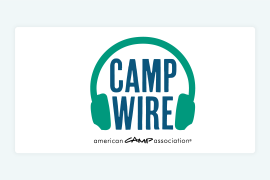Are your website and social media as accessible as they can be for all prospective campers and families that may want to attend? If they visit your website, is there more than just diverse imagery indicating your camp is welcome to all?
Consider making the following tweaks to your website and other online platforms to enhance the online experience for a wider range of participants.
Alternative Text for Images
This is one of the easiest changes you can make. In your content management system (CMS), you likely have the option to add ALT text to images. ALT text isn’t just good for SEO purposes. It helps those with visual impairments understand the imagery included on the page. Simply describe what’s happening in the image, and you’re good to go! For example, “Two kids playing in a sprinkler while wearing green T-shirts with white stripes on the sleeves” is more than enough to get the point across.
Captioned Videos
A number of video platforms, like YouTube, have auto-captioning features, which make it easier than ever to include captions when uploading your content. However, even if the platform doesn’t have this step, you should take the time to transcribe the video and add the captions in video-editing software.
Not only are captions useful for individuals that don’t want to or can’t listen with sound, but it helps those who are hearing impaired understand what’s going on.
Readable Fonts and Colors
Using fancy fonts and low-contrast color combinations can make reading really difficult for those with visual impairments or learning disabilities like dyslexia. Keep it simple, and show your camp’s personality in other fun ways, like with pictures or through the actual words you use to describe all your exciting offerings.
Language Options
Provide language options if your camp serves a diverse population. If you’re using a CMS platform like WordPress, there are free plug-ins you can install that provide the ability for visitors to translate the pages on your site. This can be helpful for non-native speakers or folks who are more comfortable communicating using a language other than English.
Accessible Social Media
Apply all the above tips to your social media, too! These platforms are where you do your best marketing and where the majority of folks likely hear about your camp, so ensuring you’re using best practices will go a long way in ensuring your organization is seen as an inclusive and accessible place for all.
Accessibility Statement
Add a statement to your website that outlines your commitment to inclusivity. Plus, include contact information for individuals who may require assistance. This may seem like an obvious tip, but prospective participants may not know how accommodating your camp is without explicitly being told so.
These tips only scratch the surface of the ways you can update your online presence to be more accessible to current and future participants and their families. For more information and best practices, check out Guidance on Web Accessibility and the ADA.
This blog is sponsored by ACTIVE Network. At ACTIVE Network, our Camp & Class Manager software is equipped with digital tools that help camp directors foster community and boost their brand. Whether your organization needs new tools to execute marketing and communications initiatives, produce meaningful data and customizable reports on your audience, or even sell camp apparel, experts at ACTIVE can connect you to the right solutions to get the job done and help your camp find success.
Periodically, the American Camp Association (ACA) makes timely and relevant information about products and services available to its members so they can make informed decisions for their camps. However, the ACA does not endorse products, services, or companies.




